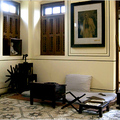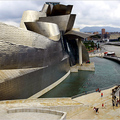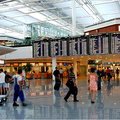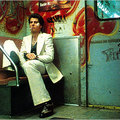
Contemplating the peak of Lonesome Mountain from the icy waters of Becker Lake.
TEN THOUSAND feet above sea level, just north of the Wyoming-Montana border, lies Albino Lake, a fish-shaped oblong of icy water bounded on its east by a reddish, rock-slide-scarred ridge and on its west by the high, bare peak of Lonesome Mountain. A few tiny, rocky islands poke up from the water, and on one stands a thatch of purple wildflowers that glow like neon in the golden light of late afternoon. When night falls, the surface of the lake turns silver, then black. The rough stillness in the air is a constant reminder that, although a thin trail runs along the shore, this is the very edge of civilization — the frontier.
It was here, on the lake’s gentle, mossy southern slopes, that my friend Mary Ellen Hitt and I camped on our second night in the Absaroka-Beartooth Wilderness, a section of the Gallatin National Forest just northeast of Yellowstone. All summer long, I’d been wanting to experience America the most frugal way possible — and to live out my “Man vs. Wild” fantasies — and these 920,377 acres of mountains, lakes, streams and valleys, recommended by several readers, seemed like a perfect place to do it.
I hadn’t, however, wanted to enter the wilderness alone. Though I’d pitched my tent numerous times on this journey, I’d never done so more than a dozen yards from my Volvo. But when I mentioned my plans to Mary Ellen, a tough little 20-year-old I met in Vietnam a few years ago, she offered to fly in from the East Coast.
Had she ever camped out before?
“I’m from Maine,” she said.
I told her to buy a ticket.
As it turned out, she had never slept far from a car, either. We were both young and fit, with good balance, strong backs and a basic understanding of “leave no trace” hiking (i.e., whatever you take in, you take out). But we were also both amateurs, infinitely amused by the directions on a can of bear spray (“In some cases, you may have to wait until the bear is quite close”) and gleefully picking packets of miso soup and cans of cumin-flavored black beans from supermarket shelves, but unsure of just how far we could hike over four days and three nights in the backcountry.
Still, the clerks at Sylvan Peak Enterprises (9 South Broadway Avenue, Red Lodge, Mont.; 406-446-1770) who sold us topographical trail maps ($7.50 each) didn’t bat an eye when we described our plans. In fact, they helped us plan a route that led from the Island Lake trailhead (on the Wyoming side of the impossibly scenic Beartooth Highway) up into Montana and around a few lakes, then back down to the Beartooth Lake trailhead, where we’d hitchhike back to the Volvo. It was a 20-mile trek, and it sounded easy.
And at first, it was. We arrived at Island Lake late on Thursday and marched along a well-marked trail into the wilderness, and even with a gray drizzle bouncing off our lightweight waterproof shells, the beauty of the Beartooths was immediate. Island Lake stretched out next to us, fed by trickling streams that we had to hop over or cross on chunks of stone. Beyond hills rose into pine-strewn ridges and buttes whose mix of gray, blond and russet rock reminded me of the temples of some wiry, weathered mountaineer.
That evening, on a swell above Night Lake, we pitched our tent (bought at Eastern Mountain Sports for $191.20, a 20 percent discount), fired up the portable gas stove and feasted on prepackaged but organic Annie’s macaroni and cheese, Maine beef jerky and swigs of good Scotch from my flask. The tent’s rain fly kept us dry, and I slept soundly in my three-season sleeping bag — artificially insulated, therefore cheaper — on a thick, comfy sleeping pad ($94.95, but a worthwhile splurge).
The rain, however, only got worse in the morning and we stayed inside our tent until well after 9 a.m., wondering if we had made a huge mistake in coming here at all. But then the downpour lightened to a pitter-patter, then ceased entirely as the sun emerged. We drank our morning Nestlé 3-in-1 instant coffee, packed up the gear and began our hike in earnest.
In the daylight, the damp land sparkled before us, and we went north, diverging briefly from the path to climb several hundred feet of rock for a view of three secluded lakes. High above the land, we could see the brilliant reflections of water tucked away amid the forests, and patches of snow and ice on peaks, but the last stretches of ridge were too much to climb. So instead we stopped for lunch and cooked chili-lemongrass noodle soup (85 cents a packet in Cody, Wyo.), topped it with a fried egg and dined with the best view imaginable.
Back on the trail, we tried to make northward progress, but were tempted by Becker Lake, which offered dozens of places to swim. Gunmetal clouds were approaching, but we didn’t care — we pulled off our clothes and soaked in the frosty water until I started imagining the news reports: “The bodies of two naked tourists were pulled from Becker Lake today after a lightning storm. ...” We got out, dried off and started hiking just in time to be hit by another downpour. Still, getting wet was better than getting electrocuted.
The weather had cleared by the time we arrived at Albino Lake, and we knew we had to camp there — the beauty was overwhelming. We pitched the tent and made dinner — shitake mushrooms cooked into Cajun-style rice-and-beans — then smoked my Cuban cigarillos, drank Black Maple Hill bourbon from my silver Tibetan flask and danced to salsa music from my shortwave radio until the sun sank behind Lonesome Mountain.
When it was fully dark, we shut off the radio and were preparing for bed, when Mary Ellen, sitting on a boulder outside the tent, whispered, “Look!”
There, on the other side of the boulder, were 10 mountain goats, standing stock-still in a line, their thick white coats illuminated by the nearly full moon. They looked like ghosts, and they stared at us intently.
Slowly, they began to move toward us, stopping to sniff the pair of jeans I’d left to dry on another stone. One, apparently the leader, walked up to us and snorted — I swear I could see the moonlit ridges of his horns — then turned and tramped away, followed by his herd. Two were kids, and they bleated in a high pitch that sounded like a meow.
Mary Ellen and I stayed on the boulder, listening to the hollow clop of the goats’ hooves and the gleeful munching of tall grasses. Finally, they walked up the ridge and crossed over, silhouetted by the gleaming moon. We said nothing for a long while.
Whether the goats were a good or ill omen, I never figured out. The next day’s hike was a challenge. After a short hike to Jasper Lake, we consulted our maps and decided to leave the trail. Heading south, we saw, led us to Golden Lake, and below it Hidden Lake — and who wouldn’t be tempted by that name?
To reach it, however, we first had to navigate the slopes of Golden Lake, which were covered with ice and fallen rocks. Some were twice the size of my car, others mere pebbles, and they were mostly stable — mostly. We’d heard two rockslides the day before, and as we picked our way around the lake, our overweight packs throwing us off balance, we were acutely aware that a sudden peal of thunder could send down a shower far more deadly than rain.
But we made it. After climbing one last 300-foot hill, we gazed down into a long, deep canyon, its sides piled high with rocks, a crystalline stream rushing through its center toward a lush, green valley. Miles beyond, successive outlines of mountains etched the skyline in ever-fainter shades, and somewhere in between, we knew, was Hidden Lake.
As we maneuvered down this Hidden Valley, we realized Golden Lake had been a mere warm-up. This next descent demanded unstinting concentration, precision-timed leaps (with 40 pounds on our backs) and, when the canyon narrowed and the stream broadened, brute force of will.
Four hours later, our thighs and backs so sore we no longer noticed the weight, we arrived at Hidden Lake and trudged through the stream’s delta, soaking our shoes. The sun was setting, and after climbing one last, defiantly steep hill on which we’d camp, we felt both triumphant and defeated. To look at Hidden Lake was to see not only the splendor of nature but also its isolating power — we were the only humans here, the lake was ringed with cliffs, and there was no way out but to climb, climb, climb.
That night, we ate more mushrooms, rice and beans and played our harmonicas around a campfire, knowing the next day might be the toughest yet.
“I just want to see my Volvo again,” I said.
The trail we followed the next morning might have been made by man, or by beast, but it went straight up into the woods atop the ridge, vanishing and reappearing with disturbing frequency. Somewhere ahead was a proper trail, pocked with boot prints and horseshoes, but to find it we had to scan our maps, whip out the compass and backtrack half a mile before it leapt into focus. It took the better part of the afternoon, and our feet whined with blisters, but we finally found it. From there, it was a simple but endless slog, down through breathtaking valleys, up over lung-searing passes. Only the majesty of the buttes — and the dream of a steak dinner — kept us going.
By the time we reached the Beartooth Lake trailhead, Mary Ellen and I were exhausted, skinny, filthy and invigorated. Near the parking lot, we bumped into Ann Davey, a middle-aged woman from the suburbs of Billings, Mont., who was asking hikers about their journeys.
“That’s quite an accomplishment!” she exclaimed when we told her about ours. Only seasoned hikers — or crazy ones — attempted to enter Hidden Valley, she said, adding, “I’m just so happy to hear you did it.” Then she offered us a ride back to my car.
As her big white Suburban trundled uphill toward Island Lake, I wondered where we fit in: Were we now experienced, certifiably crazy or just lucky? All I knew was that in this battle of man and woman vs. wild, there were no losers.
Next stop: Oregon and Washington.






